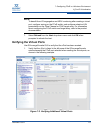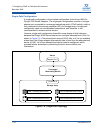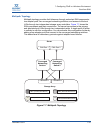
7–Configuring FCoE in a Windows Environment
Boot from SAN
FE0254601-00 A 7-15
Boot from SAN
For legacy servers, the most common boot method was to boot from a
direct-attached disk. When booting from a direct-attached disk, the server
BIOS/UEFI locates the SCSI/IDE adapter BIOS, which contains instructions that
enable the server to determine which of its internal direct-attach disks is the boot
device. This boot method is called local boot. Local boot is not fault tolerant, and it
does not allow centralized management of operating system images for rapid
deployment scenarios and disaster recovery options. While many modern servers
provide high-availability local disk configurations through server-based RAID
controllers, other issues with local boot are paving the way for alternative boot
methods.
The boot-from-SAN method places the boot device on the SAN—not locally on
the server, as with direct-attached disks. This boot device is a LUN that resides on
a Fibre Channel storage array device. The server communicates with the storage
array on the SAN through a Fibre Channel Adapter or a Converged Network
Adapter. The adapter boot code (BIOS or UEFI) contains the instructions that
enable the server to find the boot disk on the SAN.
Because the boot device resides on the SAN, it simplifies server management.
Separating the boot image from each server allows administrators to leverage the
advanced capabilities of storage arrays to achieve high availability, improved data
integrity, rapid provisioning, and more efficient storage management. Replacing a
failed server is as easy as moving the Converged Network Adapter to a new
server, pointing it to the SAN boot device, and booting up the new host.
All QLogic 8100 Series Adapters enable a host to boot from any of the supported
versions of Microsoft Windows operating on the SAN.
Boot-from-SAN Requirements
Host/Server Requirements
Server requirements depend on the type of server, the SAN installation, and the
network environment. Consider the following recommendations:
If you plan to configure boot-from-SAN on production servers, back up all
disks before proceeding.
Set the boot order in the system BIOS configuration menu: first, the optical
drive, then the disk, and then the SAN-boot device. Placing the optical drive
at the top of the boot order enables the server to boot from Microsoft
Windows installation media and then install the operating system on the
SAN boot device. If the boot media is a PXE server (for LAN boot), place the
QLogic 8100 Series Adapter at the top of the boot order. For more
information about PXE boot, refer to “PXE Boot” on page 6-25.


















